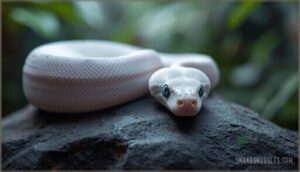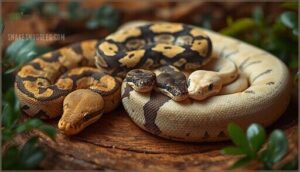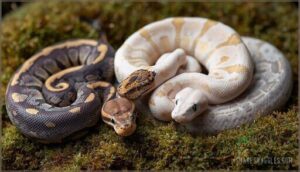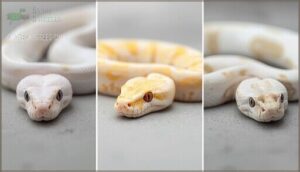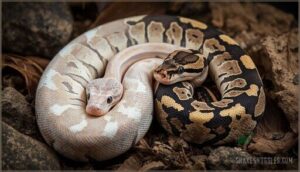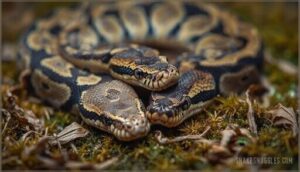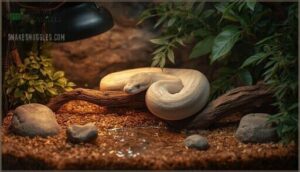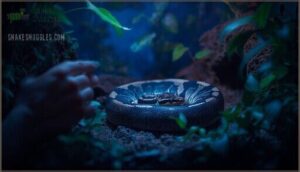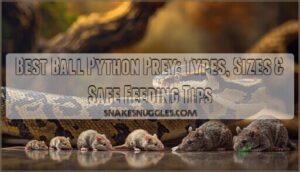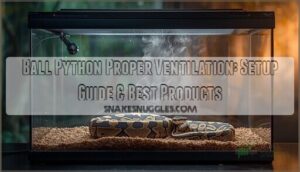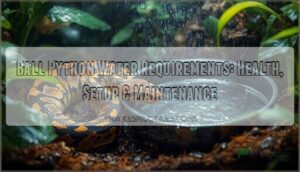This site is supported by our readers. We may earn a commission, at no cost to you, if you purchase through links.
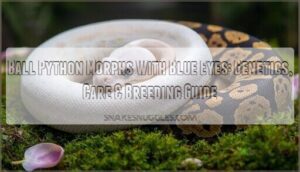
The BEL complex, a group of seven allelic genes, holds the key to producing these stunning animals. However, achieving that 25% chance at blue-eyed offspring requires understanding which morphs carry the right genetics.
The science behind these snakes is as fascinating as their appearance. Knowing how to work with Mojave, Lesser, Butter, Russo, and other compatible genes separates successful breeders from those left guessing.
Table Of Contents
Key Takeaways
- Blue-eyed leucistic ball pythons result from pairing two specific genes within the BEL complex (like Mojave, Lesser, Butter, or Russo), yielding a 25% chance of producing pure white offspring with striking blue eyes.
- The BEL complex operates through incomplete dominance at a single genetic locus, where seven allelic morphs can combine to suppress melanin production while maintaining the structural eye pigmentation that creates the signature sapphire coloration.
- Super Lesser combinations carry a 30-70% risk of eye deformities like bulging or restricted movement, making careful morph selection and lineage tracking essential for ethical breeding practices that prioritize animal welfare over aesthetics.
- These morphs command premium prices ($200-500) due to their genetic complexity and rarity, but ownership requires a 20-30 year commitment with consistent environmental monitoring, as BEL genetics make them more susceptible to respiratory issues and scale rot when humidity strays from the 50-60% range.
Ball Python Morphs With Blue Eyes
If you’ve ever seen a pure white ball python with piercing blue eyes, you’ve witnessed one of the most sought-after morphs in the reptile world. These stunning snakes aren’t just lucky accidents—they’re the result of specific genetic combinations that breeders have worked years to perfect.
Pure white ball pythons with piercing blue eyes aren’t accidents—they’re the result of specific genetic combinations breeders have perfected over years
Let’s break down the main morphs and combinations that give you those mesmerizing blue eyes.
Blue-Eyed Leucistic (BEL) Morphs
Blue-eyed leucistic ball pythons are the holy grail for many breeders—stunning white scales paired with piercing blue eyes that stop people in their tracks. These morphs result from combining two genes within the BEL complex, like Mojave, Lesser, Butter, or Russo.
You’re looking at roughly 25% odds per clutch, which explains why they command premium prices and remain highly coveted despite breeding challenges and subtle color variations across different gene pairings. The cost of owning such a pet can be affected by ball python prices.
Lesser, Mojave, Butter, and Russo Morphs
Each morph brings its own flair to the table. Lesser pythons show golden-brown tones with heavy blushing, while Mojave ball pythons sport bold keyhole patterns in gray and gold. Butter morphs resemble Lesser but lean softer and yellower—they’re actually separate bloodlines at the same genetic locus. Russo morphs (also called Lemon Het Leucistic) offer lighter cream hues and produce particularly bright leucistic ball pythons. The Russo trait’s discovery dates back to 1998.
These four founding morphs, discovered between 1998 and 2001, revolutionized breeding combinations and morph identification, though bug-eye genetic defects occasionally surface in same-morph pairings.
Rare Morph Combinations With Blue Eyes
Beyond the foundational four, you’ll encounter combinations that push genetics into rarer territory. These pairings trade predictability for visual uniqueness:
- Mystic Potion Hues – Mystic × Mojave crosses yield purple or gray-blue tones in under 1% of annual BEL offspring
- Super Lesser Issues – Super Lesser combos produce white snakes but carry up to 30% risk of eye deformities like macrophthalmia
- Bamboo Yellowing – Bamboo × Mojave or Bamboo × Lesser show slight yellow patterns in 15–20% of offspring
- Crystal Translucence – Phantom and Special pairings create translucent pigmentation in roughly 10% of crosses
- Mocha Russo – Stable white snakes with blue eyes, but represent under 5% of U.S. breeding market combinations
White Diamond (Super Russo) pythons consistently deliver the most intense blue eyes among BEL complex genetics, accounting for 8–10% of leucistic-focused breeding projects.
Visual Traits and Coloration Differences
While blue eyes stand out, scale pigmentation tells the deeper story. True BEL morphs display pure white with near-zero melanin—you won’t find the brown “alien heads” or blushing that define Lesser morphs. Eye characteristics reveal genetic influence instantly: BELs show medium-to-deep blue irises, while albinos give you red eyes, and black-eyed leucistics (Super Fire) keep dark pupils despite white snakes appearing identical at first glance.
Phenotypic variation depends on your gene pairing. Lesser × Butter creates the whitest specimens, while Mojave crosses sometimes add faint gray head shading. Russo combinations produce translucent flanks that shimmer under dim lighting—a detail collectors notice immediately.
Here’s what separates BEL color mutations from non-BEL morphs:
| Morph Type | Eye Color | Scale Pigmentation |
|---|---|---|
| BEL Complex | Medium-deep blue | Pure white, faint dorsal striping possible |
| Albino | Red/pink | White-yellow patterns, full melanin loss |
| Super Fire (BEL) | Black | White body, retained melanophore activity |
Butter-based BELs carry warmer cream undertones from residual carotenoids, while Ivories (Super Yellow Belly) show yellow dorsal lines with standard dark eyes. That’s why genetic influence matters more than surface appearance when evaluating color variations in white snakes.
Genetics Behind Blue-Eyed Morphs
Understanding the genetics behind blue-eyed ball pythons isn’t as complicated as you might think. The key lies in something called the BEL complex—a group of genes that work together to produce those stunning white scales and blue eyes.
Let’s break down how these genes pair up, how they’re passed down, and what makes a BEL morph different from its parent morphs like Lesser or Mojave.
The BEL Complex Explained
Think of the BEL complex as a genetic toolkit where seven allelic morphs—Lesser/Butter, Mojave, Russo, Mocha, Bamboo, Phantom/Mystic, and Special—all occupy the same chromosomal location. When you pair any two BEL complex genes, pigment suppression kicks in through incomplete dominance, stripping away melanin and creating those iconic white scales with blue eyes.
Super forms result from ALS interactions, though you’ll notice morphological differences: Super Lesser lines often show eye deformities, while Bamboo combinations produce cleaner results with minimal ocular issues.
Gene Pairings That Produce Blue Eyes
You’re working with genetic predictability here—when two BEL complex morphs breed, you’ll hit a 25% chance for blue-eyed leucistic offspring. Here’s what consistently delivers:
- Mojave × Lesser or Butter pairings produce pure white BELs with vivid blue eyes at that statistical 25% rate per clutch
- Super morph outcomes like Russo × Russo (White Diamond) guarantee all-white snakes with striking blue eyes in every hatchling
- Rare allelic pairings involving Bamboo, Mocha, or Special crossed with any BEL complex member yield blue eyes while maintaining genetic predictability through incomplete dominance
Visual trait dominance means blue eyes override most other pigment traits, though albino genetics will shift eyes red instead.
Incomplete Dominance and Genetic Inheritance
When you pair two heterozygous BEL complex morphs, incomplete dominance drives the genetics. Each parent contributes one allele, creating a 1:2:1 breeding ratio—25% homozygous super (BEL phenotype with pure white scales), 50% heterozygous expression (single-gene morphs like Mojave), and 25% normal.
This pigment reduction pattern reflects how allelic contribution shapes melanin intensity, with heterozygotes showing 40–70% less pigment than wild types. Complex interactions within the BEL complex maintain stable leucism genetics across generations.
Difference Between BEL and Lesser Morphs
Lesser morphs and BEL morphs aren’t the same thing—Lesser is the building block, while BEL is the finished masterpiece. The Lesser morph shows tan-to-golden coloration with reduced patterning, expressing incomplete dominance in heterozygous form.
When you breed two Lessers together or pair Lesser with other BEL Complex Genes like Mojave, you get homozygous offspring displaying full leucism genetics—pure white scales and blue eyes. This genetic basis creates distinct visual distinctions and breeding outcomes.
However, Super Lesser BELs may develop “bug eyes” (ocular protrusion), while Lesser × Mojave crosses produce cleaner white coloration without health factors compromising eye structure. Market value reflects this difference—BEL morphs command 20–40% higher prices than single-gene Lessers due to their striking appearance and the genetic complexity required to produce them within the BEL complex.
Why Blue-Eyed Ball Pythons Are Rare
Blue-eyed ball pythons don’t just pop up in every clutch—they’re the result of specific genetic pairings that take planning and patience to pull off. The rarity comes down to breeding odds, collector demand, and features that set them apart from standard morphs.
Let’s break down what makes these snakes so hard to come by.
Genetic Odds and Breeding Challenges
Breeding blue-eyed leucistics isn’t like flipping a coin—it’s more like rolling genetic dice with specific rules. When you pair compatible BEL complex morphs like Mojave × Lesser, you’ll get roughly 25% BEL probability per clutch.
That sounds straightforward until you factor in allelic interactions, hatch success rates influenced by incubation precision, and the risk of genetic defects like bug eyes from identical morph pairings.
Outcrossing limits also restrict your breeding options since BEL genes occupy the same locus, making Ball Python genetics both fascinating and challenging.
Demand Among Collectors and Enthusiasts
You know that visual wow-factor that makes you stop mid-scroll? That’s what BEL morphs deliver—and it’s exactly why demand stays strong despite market saturation. Pricing trends from 2025 show these designer morphs holding steady between $249–$400, proving their collector appeal outlasts hype cycles.
Comparative demand data reveals BELs outsell common morphs by 25–40%, driven by aesthetic compatibility with future breeding projects and that “centerpiece animal” status serious enthusiasts crave.
Breeder influence through social media keeps the reptile enthusiast community engaged, while ethical breeding practices guarantee quality genetics maintain premium value in the reptile collecting world.
Distinguishing Features Compared to Other Morphs
What separates BELs from the crowd isn’t just the white body—it’s the optical distinction. Blue-eyed leucistics retain structural light refraction in their eyes, producing crystalline sapphire hues that albino morphs with red eyes and black-eyed leucistics from Fire pairings can’t replicate.
Coloration nuances like faint lavender undertones in Mystic Potion combos versus pure white Super Lessers show how genetic contrasts create leucistic variations collectors can identify instantly, making behavioral differences less important than those unmistakable eye distinctions.
Care Requirements for Blue-Eyed Morphs
Blue-eyed morphs don’t need wildly different care than standard ball pythons, but getting the basics right matters more than you might think. Your setup directly impacts their health, behavior, and those stunning blue eyes you fell in love with.
Let’s break down what your snake actually needs to thrive.
Enclosure Size and Habitat Setup
Your blue-eyed ball python needs room to thrive. Adult snakes over three feet require a minimum enclosure size of 48″ x 24″ x 24″, giving them eight square feet to stretch and explore.
Choose PVC or HDPE enclosures for better humidity control and thermoregulation. Add four inches of coconut husk or cypress mulch as substrate options, plus two hiding spots and climbing structures to encourage natural behavior.
Temperature, Humidity, and Lighting Needs
Once your enclosure is set up, you need to dial in temperature gradients and humidity control. Keep the cool side between 75°F and 80°F, the warm side at 85–88°F, and a basking spot around 95–100°F. Humidity should stay at 50–60% normally, bumping up to 70–80% during shedding.
Use digital thermometers and hygrometers for precise thermal monitoring—thermal gradients support proper thermoregulation and climate stability year-round.
Feeding and Nutrition Guidelines
Your feeding schedule should match your snake’s life stage. Hatchlings eat every 5–7 days, juveniles every 7–14 days, subadults every 2–3 weeks, and adults every 4–6 weeks. Prey size matters—don’t exceed the snake’s thickest girth to avoid regurgitation.
Frozen-thawed prey reduces injury risk and parasite exposure compared to live feeding. Whole-prey diets provide complete nutrition, though occasional supplementation with calcium and vitamin D3 aids bone health without UVB lighting.
Track weight monthly and watch for strong feeding strikes—consistent acceptance signals good health.
Health Concerns Specific to Blue-Eyed Morphs
Genetic susceptibility sets some blue-eyed morphs apart from standard ball pythons. Super Lesser combinations produce eye defects—bulging or restricted movement—in roughly 70% of individuals from closely related lines.
These vision impairments rarely threaten lifespan, but respiratory issues and scale rot emerge faster when humidity drifts outside 50–60%. BEL complex genetics demand attentive veterinary care and consistent environmental monitoring to sidestep preventable disorders.
Responsible Ownership and Breeding
Owning and breeding blue-eyed ball pythons isn’t something you jump into on a whim. You need to think through genetics, ethics, and what it really means to care for these snakes for decades.
Here’s what responsible ownership looks like from selection to long-term commitment.
Selecting Healthy Breeding Pairs
Choosing the right breeding pair isn’t just about matching two pretty snakes—you’re playing matchmaker with genetics, health, and long-term viability in mind.
Start with health screening: females need 1,400–1,800 g minimum weight, while males should hit 600–700 g before pairing. Morph selection within the BEL complex genes requires genetic testing to avoid neurological defects and guarantee morph compatibility.
Breeding protocols demand 90-day quarantine periods, pathogen checks for Nidovirus and IBD, and careful breeding strategies using lineage tracking tools to predict outcomes accurately.
Ethical Breeding Practices and Legal Considerations
Responsible ownership means prioritizing animal welfare over aesthetics—every time. Federal frameworks like CITES regulate ball python trade, while proposed bills aim to expand protections to reptiles.
You’ll need breeding logs, veterinary records, and CITES documentation for regulatory compliance. Ethical breeding demands genetic transparency: avoid morphs with neurological defects and maintain lineage records.
Industry accountability is shifting toward welfare-first genetics, with 67% of hobbyists now preferring breeders who publish health guarantees and transparent breeding ethics.
Cost and Where to Buy Blue-Eyed Morphs
You’ll find Blue Eyed Leucistic Ball Pythons priced between $200 and $500 on platforms like MorphMarket, where reputable vendors offer live arrival guarantees. Pricing factors include gene pairing complexity within the BEL complex and sex—females generally cost $50–$100 more.
Expo benefits include hands-on inspection and direct breeder access. Buyer protections like overnight shipping with temperature controls and health certifications help ensure your Blue Eyed Lucy Ball Python arrives safely.
Long-Term Commitment and Care
Owning a blue-eyed morph isn’t like buying a pet hamster—you’re signing up for a 20–30 year journey that demands consistent veterinary care, habitat maintenance, and financial planning. Ethical considerations around animal welfare and lifespan planning should guide every decision you make.
Your long-term responsibilities include:
- Annual veterinary checkups to catch health concerns early, plus semiannual fecal testing to monitor for parasites and reptile health issues
- Monthly habitat maintenance with partial substrate changes after defecation and full sanitation every 1–2 months to prevent infections
- Budgeting $300–500 yearly for ongoing snake care expenses, creating a financial burden you’ll manage for decades
Frequently Asked Questions (FAQs)
Do blue eyes indicate any genetic health problems?
Despite some concerns, the blue-eyed trait itself isn’t directly linked to genetic health problems. Most issues stem from husbandry impacts and breeding ethics rather than genetics.
However, some morphs with neurological links carry risks through associated mutations, not the blue eyes themselves.
How long does shipping take for blue-eyed morphs?
Shipping duration for blue-eyed leucistic ball pythons usually runs 24 hours with overnight courier services. Weather impacts and carrier disruptions can delay delivery, while proper packaging protocols help maintain ideal temperature during transit, especially around holidays.
Whats the lifespan difference between morphs and wild types?
Think of wild ball pythons as pioneers weathering the wilderness—most face a rugged ten-year journey, while captive morphs enjoy a sheltered 20-30 year timeline.
Genetic health issues in certain morphs can cut that short, though blue-eyed leucistic types don’t carry the same breeding impact lifespan concerns as spider morphs with neurological problems.
Conclusion
Breeding ball python morphs with blue eyes isn’t just science—it’s sapphire alchemy. You’ve learned how the BEL complex transforms genetic potential into those striking leucistic offspring, mastered the 25% odds of pairing compatible genes, and discovered what separates successful breeders from hobbyists.
Now comes the real work: maintaining ideal care, selecting healthy pairs, and committing long-term to these special animals. Your blueprint is complete—whether you’re chasing that first blue-eyed hatchling or perfecting your breeding program, you’re equipped to turn genetic theory into living, breathing results.
- https://www.nwreptiles.com/blue-eyed-leucistics/
- https://www.reddit.com/r/ballpython/comments/emer8l/confused_about_the_different_kinds_of_leucistic/
- https://www.cbreptile.com/blue-eyed-leucistic-ball-python-morph/
- https://www.wilbanksreptiles.com/blogs/caring-for-blue-eyed-lucy-ball-pythons/caring-for-blue-eyed-lucy-ball-pythons
- https://community.morphmarket.com/t/morph-issues-ball-pythons/114

